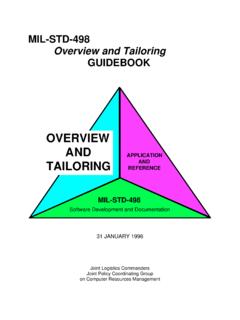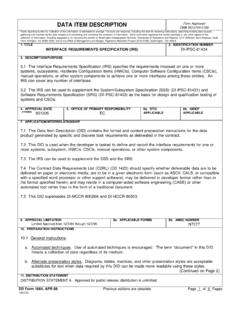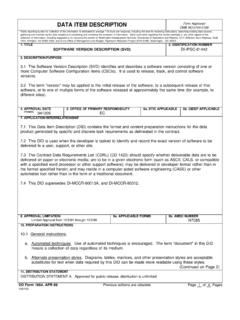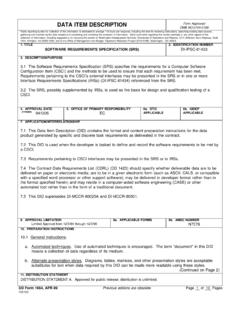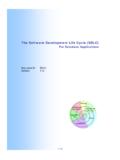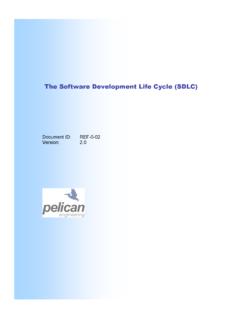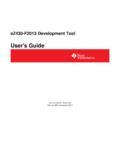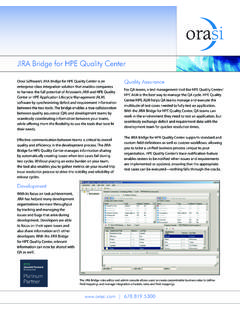Transcription of SOFTWARE DEVELOPMENT AND DOCUMENTATION
1 NOT MEASUREMENT. SENSITIVE. MIL-STD-498. 5 December 1994. (PDF version). Superseding DOD-STD-2167A. 29 February 1988. DOD-STD-7935A. 31 October 1988. DOD-STD-1703(NS). 12 February 1987. MILITARY STANDARD. SOFTWARE DEVELOPMENT . AND DOCUMENTATION . AMSC NO. N7069 AREA: IPSC/MCCR. DISTRIBUTION STATEMENT A. Approved for public release; distribution is unlimited. MIL-STD-498 (PDF version) Foreword Page ii FOREWORD. 1. This Military Standard is approved for use by all Departments and Agencies of the Department of Defense. 2. Beneficial comments (recommendations, additions, deletions) and any pertinent data which may be of use in improving this document should be addressed to SPAWAR 10-12, 2451 Crystal Drive (CPK-5), Arlington, VA 22245-5200.
2 The comments may be submitted by letter or by using the Standardization Document Improvement Proposal (DD Form 1426) appearing at the end of this document. 3. This standard merges DOD-STD-2167A and DOD-STD-7935A to define a set of activities and DOCUMENTATION suitable for the DEVELOPMENT of both weapon systems and Automated Information Systems. A conversion guide from these standards to MIL-STD-498 is provided in Appendix I. Other changes include improved compatibility with incremental and evolutionary DEVELOPMENT models; improved compatibility with non-hierarchical design methods; improved compatibility with computer-aided SOFTWARE engineering (CASE) tools; alternatives to, and more flexibility in, preparing documents; clearer requirements for incorporating reusable SOFTWARE .
3 Introduction of SOFTWARE management indicators; added emphasis on SOFTWARE supportability; and improved links to systems engineering. This standard supersedes DOD-STD-2167A, DOD-STD- 7935A, and DOD-STD-1703 (NS). 4. This standard can be applied in any phase of the system life cycle. It can be applied to contractors, subcontractors, or Government in-house agencies performing SOFTWARE DEVELOPMENT . For uniformity, the term "acquirer" is used for the organization requiring the technical effort, the term "developer" for the organization performing the technical effort, and the term "contract" for the agreement between them. The term " SOFTWARE DEVELOPMENT " is used as an inclusive term encompassing new DEVELOPMENT , modification, reuse, reengineering, maintenance, and all other activities resulting in SOFTWARE products.
4 5. This standard is not intended to specify or discourage the use of any particular SOFTWARE DEVELOPMENT method. The developer is responsible for selecting SOFTWARE DEVELOPMENT methods that support the achievement of contract requirements. 6. This standard implements the DEVELOPMENT and DOCUMENTATION processes of ISO/IEC DIS. 12207. It interprets all applicable clauses in MIL-Q-9858A (Quality Program Requirements) and ISO 9001 (Quality Systems) for SOFTWARE . 7. This standard includes all activities pertaining to SOFTWARE DEVELOPMENT . It invokes no other standards. It can be applied on its own or supplemented with other standards, such as those identified in Section 6. If other standards are applied, the acquirer is responsible for resolving any conflicts that arise.
5 8. Data Item Descriptions (DIDs) applicable to this standard are listed in Section 6. These DIDs describe the information required by this standard. 9. This standard and its Data Item Descriptions (DIDs) are meant to be tailored by the acquirer to ensure that only necessary and cost-effective requirements are imposed on SOFTWARE DEVELOPMENT efforts. General tailoring guidance can be found in Section 6 and in DOD-HDBK- 248. Tailoring guidance specific to this standard can be found in Appendixes G and H and in guidebooks and handbooks planned for this standard. MIL-STD-498 (PDF version). CONTENTS. Paragraph Page 1. SCOPE .. 1. Purpose .. 1. Application .. 1. Organizations and agreements .. 1. Contract-specific application .. 1. Tailoring.
6 1. Interpretation of selected terms .. 1. Interpretation of "system" .. 1. Interpretation of "participate" in system DEVELOPMENT .. 2. Interpretation of "develop," "define," etc .. 2. Interpretation of "record" .. 2. Order of precedence .. 2. 2. REFERENCED DOCUMENTS .. 3. 3. DEFINITIONS .. 4. 4. GENERAL REQUIREMENTS .. 8. SOFTWARE DEVELOPMENT process .. 8. General requirements for SOFTWARE DEVELOPMENT .. 8. SOFTWARE DEVELOPMENT methods .. 8. Standards for SOFTWARE products .. 8. Reusable SOFTWARE products .. 8. Incorporating reusable SOFTWARE products .. 8. Developing reusable SOFTWARE products .. 9. Handling of critical requirements .. 9. Safety assurance .. 9. Security assurance .. 9. Privacy assurance .. 9. Assurance of other critical requirements.
7 9. Computer hardware resource utilization.. 10. Recording rationale .. 10. Access for acquirer review .. 10. 5. DETAILED REQUIREMENTS .. 11. Project planning and oversight .. 12. SOFTWARE DEVELOPMENT planning .. 12. CSCI test planning .. 12. System test planning .. 12. SOFTWARE installation planning .. 12. SOFTWARE transition planning .. 12. Following and updating plans .. 13. Establishing a SOFTWARE DEVELOPMENT environment .. 13. SOFTWARE engineering environment .. 13. SOFTWARE test environment .. 13. SOFTWARE DEVELOPMENT library .. 13. iii (PDF Version). MIL-STD-498 (PDF version). CONTENTS - Continued Paragraph Page SOFTWARE DEVELOPMENT files .. 13. Non-deliverable SOFTWARE .. 13. System requirements analysis .. 13. Analysis of user input.
8 14. Operational concept .. 14. System requirements .. 14. System design .. 14. System-wide design decisions .. 14. System architectural design .. 14. SOFTWARE requirements analysis .. 15. SOFTWARE design .. 15. CSCI-wide design decisions .. 15. CSCI architectural design .. 15. CSCI detailed design .. 15. SOFTWARE implementation and unit testing .. 16. SOFTWARE implementation .. 16. Preparing for unit testing .. 16. Performing unit testing .. 16. Revision and retesting .. 16. Analyzing and recording unit test results .. 16. Unit integration and testing .. 16. Preparing for unit integration and testing .. 17. Performing unit integration and testing .. 17. Revision and retesting .. 17. Analyzing and recording unit integration and test results.
9 17. CSCI qualification testing .. 17. Independence in CSCI qualification testing .. 17. Testing on the target computer system .. 17. Preparing for CSCI qualification testing .. 17. Dry run of CSCI qualification testing .. 18. Performing CSCI qualification testing .. 18. Revision and retesting .. 18. Analyzing and recording CSCI qualification test results .. 18. CSCI/HWCI integration and testing .. 18. Preparing for CSCI/HWCI integration and testing .. 18. Performing CSCI/HWCI integration and testing .. 18. Revision and retesting .. 18. Analyzing and recording CSCI/HWCI integration and test results .. 19. System qualification testing .. 19. Independence in system qualification testing .. 19. Testing on the target computer system.
10 19. Preparing for system qualification testing .. 19. Dry run of system qualification testing .. 19. Performing system qualification testing .. 19. Revision and retesting .. 19. Analyzing and recording system qualification test results .. 20. iv (PDF Version). MIL-STD-498 (PDF version). CONTENTS - Continued Paragraph Page Preparing for SOFTWARE use .. 20. Preparing the executable SOFTWARE .. 20. Preparing version descriptions for user sites .. 20. Preparing user manuals .. 20. SOFTWARE user manuals .. 20. SOFTWARE input/output manuals .. 20. SOFTWARE center operator manuals .. 21. Computer operation manuals .. 21. Installation at user sites .. 21. Preparing for SOFTWARE transition .. 21. Preparing the executable SOFTWARE .. 21.
